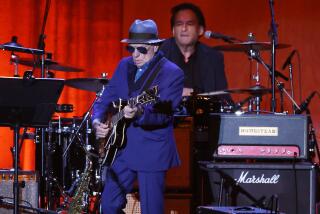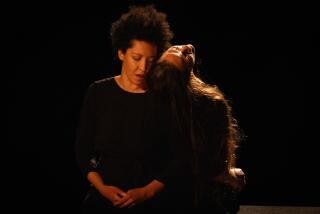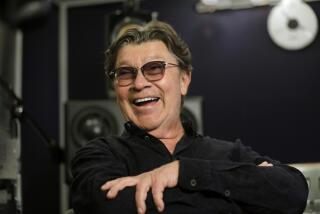MUSIC REVIEW
Mark Robson -- Los Angeles’ long-standing best-kept-secret pianist -- gave his annual Piano Spheres recital Tuesday night in Zipper Concert Hall at the Colburn School. The turnout was disappointing. The concert was not.
Robson is a powerhouse pianist with a monster technique, but his career has been largely carried on out of the limelight. He spent 14 years as an assistant conductor and coach at Los Angeles Opera. He recently performed a Beethoven cycle in a South Pasadena church. He teaches voice and diction at California Institute of the Arts. Now and then he supplies a stupefying Messiaen evening for the Jacaranda series in Santa Monica. He composes as well, but he doesn’t push his music on his audiences.
The feeling of this recital was like that of a very carefully chosen gathering of remarkable characters. In ways that are hard to quite grasp, these small pieces from different periods and different places seemed to speak to each other.
Eight composers were featured. The period of time covered was from 1906 to the present, with one world premiere. No work lasted more than 11 minutes. With the exception of three etudes by Gyorgy Ligeti, no composer was represented by anything major. Ives’ “Song Without (Good) Words” and Morton Feldman’s “Nature Pieces for Piano” were early, obscure and extremely minor.
Robson was not physically demonstrative at the keyboard. He presented rhythmically complex music and pianistically extravagant music without a lot of fuss. He was the perfect host. All of the attention was directed to the idiosyncratic guests and an appreciation of their lovable eccentricities.
The evening began with Schoenberg’s Five Piano Pieces, Opus 23. Written between 1920 and ‘23, these small pieces have been accused of doing music much harm. It was during this period, and to some extent in these pieces, that Schoenberg developed his 12-tone system and thus systematically eradicated the comforting tonal harmonies, melodies and structural character felt to be the heart of an art form.
In fact, these are little adventures -- fluid experiments in organic form. In his program notes, Robson wonderfully describes the physical interplay of Schoenberg’s rhythmic shapes as “imitations of processes from the natural world -- from cell division on up to things that go bump in the night.” When played with Robson’s combination of clarity and majesty, Schoenberg suddenly seemed the most interesting person in the room (which those who knew him said he was).
With this, the stage was set for an emphasis on the other composers’ peculiarities as well. What might the serious Schoenberg have thought of an etude by the late Argentine cutup Mauricio Kagel, which is a stream-of-consciousness string of amusing one-liners? Maybe a fight would have brewed. Patricio da Silva’s lively “Fantasy and Nocturne,” written for the occasion and commissioned by Piano Spheres, answered Kagel with pleasing harmonies and fistfuls of notes flying from the keyboard.
Etudes by Maurice Ohana and Ligeti were the cosmopolitan voices of wandering (and wondering) Jews. Ohana, a “French” composer, was born in Morocco and waited out World War II in England. Ligeti escaped Nazi-occupied Hungary and became a prime mover in the postwar German and Austrian avant-garde. Both composers layered African and European elements in their etudes, splashing pianistic color around with abandon and demonstrating terrific compositional flair.
Beat Furrer, a 54-year-old Austrian Modernist born in Switzerland, toys with tiny pinpricks of sound in his “Voicelessness. The Snow Has No Voice” from 1986. Morton Feldman’s “Nature Pieces” also spend most of their time in the pianissimo territory. Written in 1951 when the composer was 25, they were the music of a garrulous, large man delighted with his imagined delicacy.
Finally, Ives’ “Song Without (Good) Words” was a pretty song without, Ives apparently felt, good harmonies. He took care of that, as he often did, by thickening the plot.
There wasn’t a dull moment. Robson rendered each composer, even in his most minor statement, a big, unique and quirky personality. Everything the pianist touched sparkled.
--
More to Read
The biggest entertainment stories
Get our big stories about Hollywood, film, television, music, arts, culture and more right in your inbox as soon as they publish.
You may occasionally receive promotional content from the Los Angeles Times.











